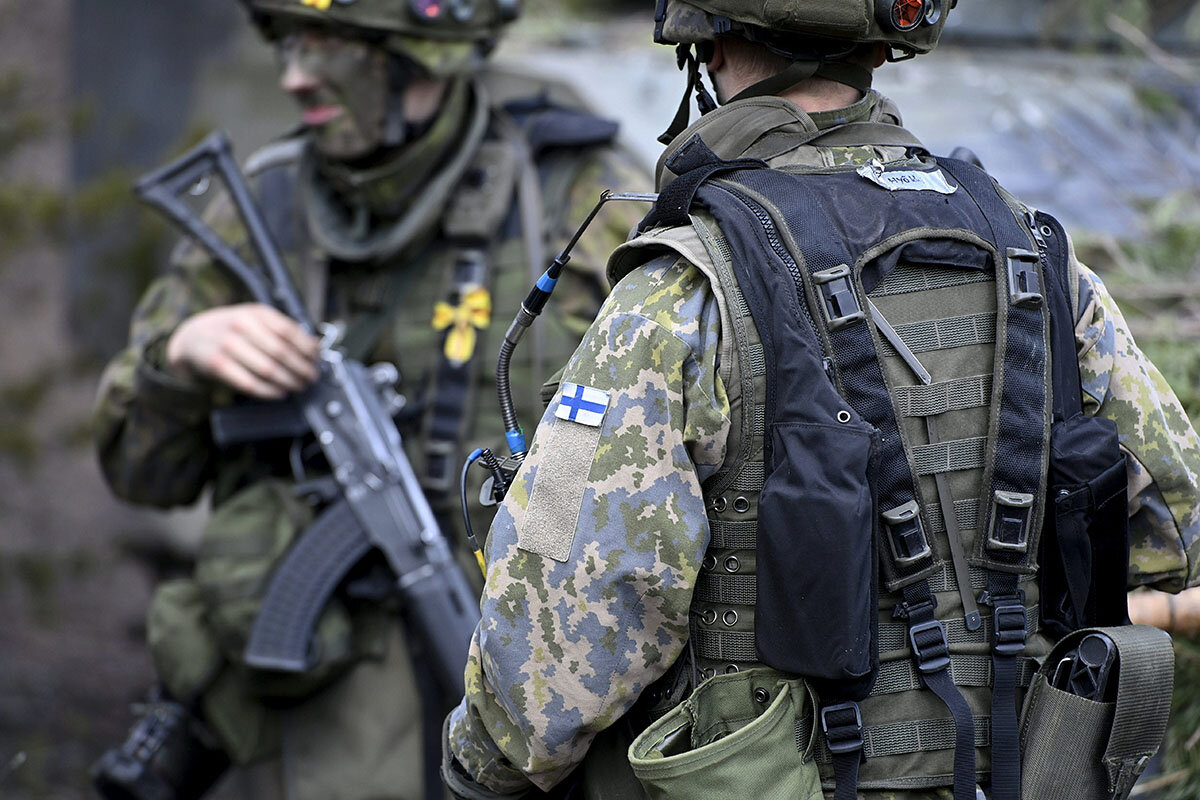Finland, NATO, and the changing calculus of European defense
Loading...
| Loppi, Finland
In a picturesque pine forest some 60 miles north of Helsinki, members of the Finnish Reservist Association crouch behind a wooden bunker barricade, shooting at torso-shaped targets in a trailer-sized trench, dug out to keep bullets from ricocheting off the region’s ubiquitous granite rock.
It is late afternoon Thursday and these reservists have come from their day jobs, ready to drill in the drizzling rain until 9 p.m. or the ammunition runs out.
Their training has taken on a new sense of urgency: Just hours before, Finnish leaders announced that their country, which shares an 800-mile border with Russia, intends to join NATO. For the Finnish people, this doesn’t mean a retreat from their long tradition of self-preparedness, but it does portend a future with the benefit of formal backup from their neighbors.
Why We Wrote This
As Finland applies to join NATO, with Sweden moving in tandem, Europe’s strategic posture toward Russia is shifting. What isn’t changing is the Finnish people’s devotion to defending their nation and its values.
“This has been a long time coming,” says Antti Kettunen, who served as a peacekeeper in Kosovo, accompanying Finnish officials investigating mass killings carried out by Russian-backed Serbian forces. “Now NATO is the only way to go.”
Less than three months ago, this was not the prevailing view. Support among Finns for joining the alliance hovered at 20%. But that figure skyrocketed nearly overnight to 76% – along with demand for military training – after Russia’s invasion of Ukraine.
Nelli Pylkkaenen, who served in the Finnish Army in 2003, decided to sharpen her skills four years ago after feeling unsettled by “the way Russia was treating its own citizens, jailing people with different opinions.”
She wanted to be ready “to defend Finnish values,” if it comes to that.
There are worries that it may. Finland and Sweden – expected to announce its intentions to join its neighbor in applying for NATO membership next week – will now be entering a “grey zone,” as defense analysts call it, before their security is guaranteed by the bedrock promise of the alliance: that an attack against one is an attack against all.
The question in the weeks to come will be how Russia will respond now that the precise scenario it was hoping to avoid by invading Ukraine – having NATO at Russia’s doorstep – is coming to fruition in Finland.
“They could do anything from blocking our postal deliveries to a nuclear bomb,” Mr. Kettunen says. “But we’re not scared – we’re prepared.”
Russia at its doorstep
Helsinki has been on the receiving end of Russian aggression throughout its history. Part of czarist Russia up until its independence in 1919, Finland was invaded by Russia once again in 1939, after a false flag attack staged by Moscow.
As with Ukraine today, the world was in awe of the fighting spirit and unexpected hammering that the Nordic nation was able to muster against the Red Army.
It was Finland that introduced the world to “Molotov cocktails” as Russian bombs reigned down on their cities – punishment for refusing to cede territory demanded by Moscow.
In an audacious early disinformation campaign, then-Soviet Foreign Minister Vyacheslav Molotov denied the siege was happening. Moscow was merely airdropping humanitarian aid to starving Finns, he told a Russian radio audience.
Retaining their sense of humor under bombardment, the Finns dubbed these attacks “Molotov bread baskets.” Their soldiers served up to Russian tanks “a drink to go along with his food parcels.”
Finnish fighters trapped and bogged down these tanks in part by exploding 143 of their own bridges and viaducts and using white-clad skiing “ghost soldiers” hidden in snow banks as snipers who targeted officers and tow truck drivers.
“Only Finland – superb, nay, sublime in the jaws of peril – Finland shows what free men can do,” Winston Churchill marveled. The Finns liked to joke that the British prime minister’s words were nice, but they didn’t explode – in other words, they weren’t desperately needed forces or weapons.
Indeed, though Finnish forces humiliated the Soviet Army in the Winter War, as it came to be known, Finland’s allies did not come to its aid. The scenario seemed to echo the 18th-century warnings inscribed on Helsinki’s beloved Suomenlinna fortress: “Future world, stand here on your own two feet and don’t rely on outside help.”
“It reinforced this sense of admonition of don’t expect foreign assistance – and don’t trust it,” says Charly Salonius-Pasternak, senior research fellow at the Finnish Institute of International Affairs.
Finland was ultimately forced into a 1948 pact with Russia and a policy of staying neutral but allowing Moscow to exercise some influence over its affairs. The setup came to bear their country’s name – Finlandization – and was raised as a possible model for Ukraine in the run-up to Russian President Vladimir Putin’s invasion.
Next door, in Sweden, “It was never an issue to join NATO, because if they did, the Soviet Union would take a much firmer grip on Finland,” says Magnus Petersson, who heads the Department of International Relations at Stockholm University.
“This would create a situation similar to the situation in Europe, with extreme tensions between East and West and increased risk of crisis and war.”
Though Sweden’s 200-year-long tradition of neutrality has been pragmatic, it has also been “an ideological position that was very important” to national identity, says Björn Fägersten, director of the Europe Program at the Swedish Institute of International Affairs.
“It was part of our general foreign policy – neutral but very activist,” criticizing nuclear proliferation, the USSR, and the U.S. in the Vietnam War.
Declassified documents have also shown that Finland and Sweden closely coordinated with the U.S. during the Cold War, sharing intelligence, “which was not widely known, but also a very clear indication of where we belonged ideologically,” Dr. Fägersten says.
The two countries officially became partners of NATO after the fall of the Soviet Union in 1994, and, during the years since, both nations have been “as close to NATO as you can be without being a member,” he adds.
And that’s just how the Finns and Swedes liked it in recent years. But as Finland’s leaders officially endorsed NATO membership Thursday, Sweden is expected to follow suit.
“You don’t want to be left alone if all your friends are joining,” Dr. Fägersten says. “Also out of solidarity: It would be difficult for NATO to protect Finland – and indeed the Baltic states – if it didn’t have access to Swedish territory.”
NATO applications on fast track?
Well in advance of this week’s announcement, Finnish officials had been making diplomatic rounds, collecting security assurances from NATO allies that they will come to Finland’s aid against Russia if necessary.
It’s in the alliance’s interest to take a strong stand: Not doing so would send the signal that Moscow can prevent any expansion of NATO.
At the same time, Finland and Sweden are well-established democracies with strong militaries and respect for rule of law – which is why their applications are expected to move quickly.
In the interim, security assurances are “of course not security guarantees – and we know the Kremlin has obviously been willing to take a lot of risk – but Russia really needs to think about its risk profile if all of these countries have said in advance that if you attack Sweden and Finland, we’re in,” says Mr. Salonius-Pasternak.
It’s not lost on Finland that there are fewer Russian forces at the border than in recent history. “They are really, really busy now in Ukraine,” says retired Gen. Jarmo Lindberg, Finland’s chief of defense until 2019.
Acting as a further deterrent, the Nordic neighbors bring their very capable militaries to the alliance, including fighter jets and submarines.
The cornerstone of Finland’s defense force is its policy of mandatory conscription for men, says General Lindberg. “We never gave it up after the Cold War, though a lot of nations did.” Women are welcome to sign up as well.
That means that there are 900,000 people out of a population of 5.5 million who have received military training. Depending on their speciality, many do additional drilling every one to five years to keep their skills sharp. Conscripts aren’t drafted to fight, because they’re considered trainees, but 280,000 reservists are immediately deemed ready for war should they be needed.
These troops are trained to make use of Finland’s imposing climate and terrain, much as their predecessors did during the Winter War. This includes building ice caves, orienteering, and skiing straight into freezing lakes – then learning how to climb out of them quickly and warm up without fire.
Finland has some 100,000 lakes, which means that “it’s difficult to move if you can’t use the roads or bridges,” notes General Lindberg, now a member of his country’s reserve forces. “So it’s common knowledge in Finland that if we need to slow down an attacker, then the means of transport should be destroyed.”
For this reason, underpasses in Finland are equipped with hooks specially made for quickly hanging antitank mines, and bridges have charges pre-inserted into supporting beams.
At the same time, by Finnish law multistory buildings of a certain height must have basements with reinforced doors and working filtration systems to act as bomb shelters. They are also built into the granite of the countryside.
The idea, in short, is “to make it prohibitively expensive for anyone who thinks it would be possible to attack Finland,” General Lindberg says.
Indeed, there’s a national joke about reserve forces so well-trained and enthusiastic that “the biggest issue would be trying to prevent them all from grabbing their hunting rifles and taking care of business themselves” in the event of an invasion, Mr. Salonius-Pasternak notes. “And the government has to say, ‘Don’t worry, go home – we’ve got this.’”
The humor has basis in truth, says Minna Nenonen, executive director of the Finnish Reservist Association in Helsinki, and the first woman to serve in that role. “Never in our association have we seen anything like this year.”
Her grandfather was a Winter War veteran, forced to relocate from his home in former Finland after it became part of Russia.
In later years, he worked with fellow veterans while a 10-year-old Ms. Nenonen sat at his elbow, hearing their stories. She decided she would join the military, too.
Now she is getting calls from women looking for training. “They are thinking about what they are seeing happen to women in Ukraine,” she says.
“Do, don’t talk”
All of this preparation, though bracingly extensive, has so far been unnecessary in the post-Soviet era.
To this end, an equally impressive – and successful – deterrent has been the understated “do, don’t talk approach” of the Finns, Mr. Salonius-Pasternak says.
In the wake of Russia’s invasion of Ukraine, for example, the military released photos showing Finnish forces training on missile systems. The pictures made it clear that the missiles had a yellow stripe, indicating a “we’re no longer kidding missile” rather than an inert weapon, he notes.
“This means nothing to the greater public – it didn’t create panic or cause headlines saying ‘Finland is arming up,’ but every intelligence agency in Helsinki, including [those of] China and Russia, took note,” Mr. Salonius-Pasternak says.
It’s an approach that comes with being an adversary of Russia, but also a neighbor, he adds.
“It’s a practical approach that gets lifted up in the political sense: The same person who’s selling goods to a Russian tourist one week can the next week do their reservist training knowing that the only reason they need to do this is if Russians attack,” he says.
“The thing is, it’s not a paradox – it’s just how things are done here.”






